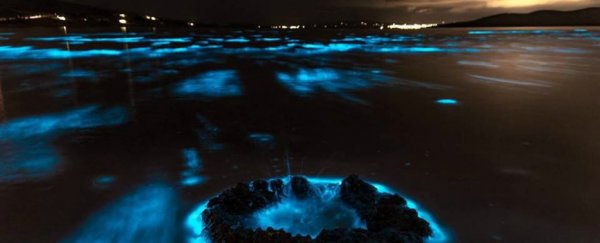In parts of Australia, it's not just the skies that light up, but the seas too.
Last month, photographers in Tasmania were enjoying the spring equinox, which is usually the best time to see the Aurora Australis (or southern lights), thanks to the presence of strong geomagnetic storms.
But some keen photographers were lucky enough to also catch the sea lighting up at the same time, thanks to the blooming of groups of dinoflagellates, called Noctiluca scintillans.
These glowing beauties have been nicknamed 'sea sparkles', and they start to glow when disturbed.
This glow, also known as bioluminescence, is caused by a reaction in the cytoplasm (the goo inside the cell) by a special type of cellular organ, or organelle, called scintillons.
The 'blooms' occur when there's a high concentration of plankton - the sea sparkles' food source - to feed on, which means more sea sparkles, and therefore a brighter glow.
Although the glow is very beautiful, these blooms aren't exactly great for the environment.
When the sea sparkles break down, they release ammonia, which in high concentrations can damage nearby marine life.
Last year there was also a huge bloom of the dinoflagellates in Tasmania's Derwent River, and the pictures (which were incredible) went viral.
"When the [sea sparkles'] cell breaks down, ammonia is released, and the massive bloom could become a deadly cloud," Lisa Gershwin, a biologist and marine expert, said at the time. "It can change the flavour of the water and it's noxious to fish."
As Business Insider explains, the fact that the blooms are happening as far south as Tasmania at all is a worry, too.
Tasmania only started seeing sea sparkles in 1994, and by 2004, the sightings were much more common.
"The displays are a sign of climate change," Anthony Richardson from the CSIRO, told New Scientist at the time.
Global warming has been pushing warm water south towards Tasmania – water which is "warm enough for Noctiluca to survive," Richardson says.
But despite not being a great sign for the environment, the images are still a pretty incredible reminder of just how beautiful the natural world can be.
Let's just hope they encourage everyone to look after it a little better.
If you want to see more images and find out where the best bloom areas are, we recommend joining Facebook group Bioluminescence Australia.


